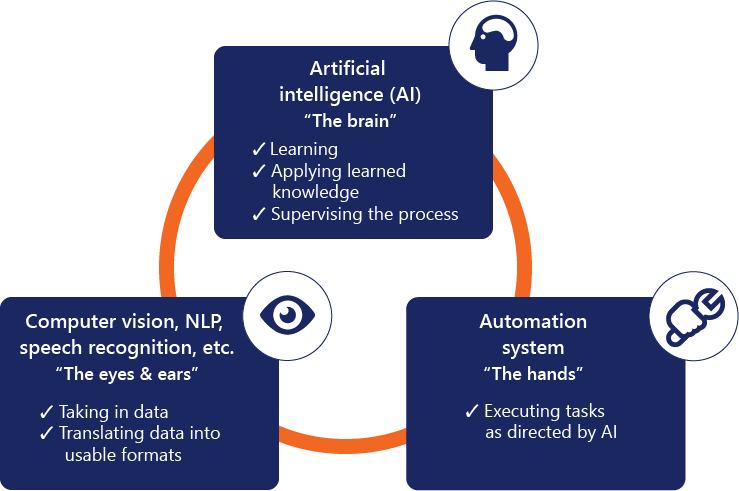5-minute read
By now the benefits of automation are well known, and thanks to the availability of cost-efficient, user-friendly automation software, more organizations are reaping the rewards. Gartner predicts that 90 percent of large businesses will adopt automation in some form between now and 2022, “as they look to digitally empower critical business processes through resilience and scalability, while recalibrating human labor and manual effort.”
As this trend accelerates, the future of automation has begun to take shape, and that future is intelligent. Many organizations are bumping up against the limitations of traditional automation and recognizing the need for a solution that goes beyond rule-based algorithms. By blending automation and AI, organizations can evolve their processes to the realm of intelligent automation, uncovering opportunities to make their processes even more efficient, less error-prone, and less reliant on human intervention.
What is intelligent automation?
Traditional automation is, for lack of a better word, “dumb,” in that it relies on rules that human knowledge workers have programmed into it (“if this, then that”). If an automated system comes across a scenario for which it has no rule in its programming, or if the data it receives is incomplete or irregularly formatted, it cannot move forward and humans must intervene. That’s why traditional automation is well-suited for simple, rule-based tasks with few exceptions, but fall short when it comes to more complex processes.
With intelligent automation—also known as intelligent process automation (IPA), smart automation, or cognitive automation—systems become more autonomous, requiring less human input. AI and related technologies—including machine learning, natural language processing, speech recognition, and computer vision—enter the picture to allow automation to go beyond the limits of rules-based programming. Whereas traditional automation systems “learn” by being manually programmed, intelligent automation learns by continuous observation.
To look at intelligent automation another way, think of the AI component as “the brain” that’s in charge of learning, applying learned knowledge, and supervising the process. Technologies such as computer vision and speech recognition are “the eyes and ears,” tasked with taking in data and translating it into usable formats. And the automation systems are “the hands” that execute the prescribed tasks as directed by the AI component.

Use case: traditional vs. intelligent automation in financial services
One area where intelligent automation is making an impact is in the financial services industry, particularly in call centers. A bank’s customer service representatives spend as much as 75 percent of their time doing manual research, including looking up offers for each caller in real time.
With traditional automation, an agent’s screen may show offers based on the customer’s geographic location or current promotions. AI and machine learning enable digital workers to search the caller’s account, combine that data with information being gathered on the call in real time, and send a predicted “next best offer” to the agent’s screen, tailored to the specific customer. This streamlined process results in
• Shorter call times: Agents have instant access to the information they need to pass on to the customer—no awkward silences while they scroll through the available offers.
• Improved customer satisfaction: More personalized offers help customers feel valued and appreciated.
• Higher conversion rates: Customers are more likely to accept offers tailored to their specific needs and preferences.
How it works
The following graphic shows how a process can evolve from a purely manual approach to traditional automation to intelligent automation, and how each layer adds capabilities that save time and effort, reduce the risk of error, and improve overall efficiency:

Benefits of intelligent automation
You may notice a striking similarity between the benefits of intelligent automation and the benefits of traditional automation, and rightly so. The primary benefit of intelligent automation is that it allows automation to do what it already does—only better, faster, and with less intervention from human employees.
Heightened efficiency
Intelligent automation eliminates many of the “speed bumps” that arise from the need for human intervention, allowing processes to execute more smoothly and efficiently.
Less programming
Because intelligent automation learns on its own, the organization reduces the need to devote resources to programming—and re-programming—its automation rules.
Higher employee satisfaction
The addition of AI reduces the number of instances that require manual intervention, enabling human workers to spend less time supervising automated processes and more time doing engaging, satisfying work.
Better customer experiences
Intelligent automation enables businesses to create more personalized customer experiences based on the sum total of past interactions rather than on rule-based algorithms, which can improve customer satisfaction and retention rates.
Improved regulatory oversight
While traditional automation relies on pre-programmed rules in monitoring transactions and processes for potential compliance violations, intelligent automation looks for patterns in the data and refers to a domain knowledge base to determine whether those patterns indicate a compliance risk. Human workers only need to enter the picture when a new pattern is discovered, and the results of the intervention feed back into the domain knowledge base to serve as a reference for future cases.
The future of intelligent automation
Businesses across industries have realized the benefits of automation, and they’re ready to take the next step. By applying artificial intelligence to automated processes, organizations can begin creating a true digital workforce capable of simulating many aspects of human thought and judgment. When this happens, the initial promises of automation—faster processes, lower costs, lower risk of error, freeing employees from the most repetitive tasks—can rise to a new level, delivering even greater benefits to the bottom line.

Digital transformation done right
We create powerful custom tools, optimize packaged software, and provide trusted guidance to enable your teams and deliver business value that lasts.


